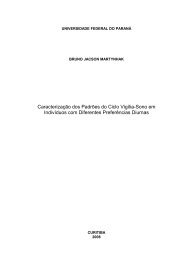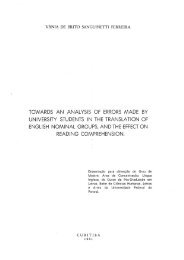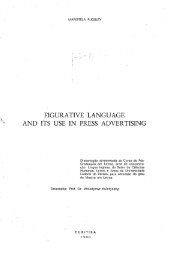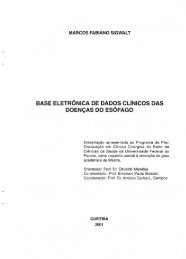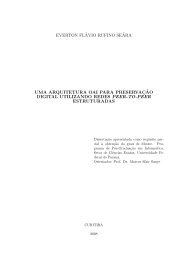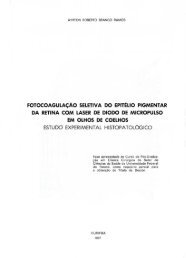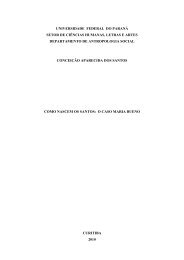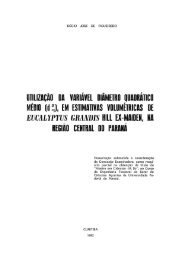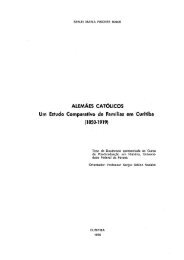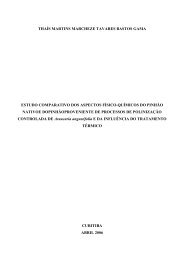- Page 1 and 2: Maikon Di Domenico POLIQUETAS INTER
- Page 4 and 5: A toda minha família e aos amigos
- Page 8 and 9: RESUMO Famílias de poliquetas excl
- Page 10 and 11: Tabela 1 - Resumo dos principais mu
- Page 12 and 13: Reymond Marcus, 1946; 1947; 1948; S
- Page 14 and 15: Referências AUGENER, H. 1913. Poly
- Page 16 and 17: SIEWING, R. 1954. Zur Verbeitung vo
- Page 18 and 19: 2.4. Alinhamento e edição das seq
- Page 20 and 21: Capítulo 1 Lista de Figuras Figura
- Page 22 and 23: dorsal anterior, indicando as glân
- Page 24 and 25: indicando o pênis (p) e as linhas
- Page 26 and 27: Lista de Tabelas Capítulo 1 Tabela
- Page 28 and 29: Capítulo 1 MANUAL DE IDENTIFICAÇ
- Page 30 and 31: Abstract All interstitial polychaet
- Page 32 and 33: A estas famílias somam-se Aeolosom
- Page 34 and 35: que foi aceito por Rouse & Pleijel
- Page 36 and 37: Figura 1. Locais de coleta nas regi
- Page 38 and 39: colocada em outro erlenmeyer, com a
- Page 40 and 41: 4- Apêndices nucais presentes.....
- Page 42 and 43: Figura 2. Polygordiidae, A; Protodr
- Page 44 and 45: Filogenia e sistemática Há apenas
- Page 46 and 47: Figura 3. Aberranta enigmatica. A:
- Page 48 and 49: neizvestnovae. Cerdas sigmóides po
- Page 50 and 51: 2005), ou ainda posicionados como S
- Page 52 and 53: Figura 4. Potamodrilus fluviatilis,
- Page 54 and 55: Ctenodrilidae Kennel, 1882 Animais
- Page 56 and 57:
eles são o grupo irmão de um clad
- Page 58 and 59:
Chave para os gêneros de Ctenodril
- Page 60 and 61:
Gênero Ctenodrilus Claparède 1863
- Page 62 and 63:
Figura 8. Ctenodrilus cf. serratus,
- Page 64 and 65:
habitante de sedimentos lamosos, h
- Page 66 and 67:
Figura 9. Nerilla mediterranea (A)
- Page 68 and 69:
(Figura 10G) - Antenas mais curtas
- Page 70 and 71:
Gênero Nerilla Claparède 1863 Ner
- Page 72 and 73:
PARERGODRILIDAE Reisinger, 1925 e H
- Page 74 and 75:
situam-se em um saco grande e produ
- Page 76 and 77:
encontrada na Croácia, República
- Page 78 and 79:
POLYGORDIIDAE Czerniavsky, 1881 A f
- Page 80 and 81:
parecem ser inervados com a parte a
- Page 82 and 83:
Distribuição: Praias do Estaleiro
- Page 84 and 85:
Polygordius leo du Bois-Reymond Mar
- Page 86 and 87:
Figura 17. Polygordius appendiculat
- Page 88 and 89:
PROTODRILIDAE Czerniavsky, 1881 Esp
- Page 90 and 91:
sugere que a origem progenética e/
- Page 92 and 93:
(CITES No. 11BR006911/DF), aguardan
- Page 94 and 95:
Machos com órgãos laterais ciliad
- Page 96 and 97:
Figura 20. Protodrilus corderoi (A;
- Page 98 and 99:
Figura 22. Morfologia externa de Pr
- Page 100 and 101:
Descrição (medidas do holótipo,
- Page 102 and 103:
Tabela 2. Características merísti
- Page 104 and 105:
Figura 24. Protodrilus sp. nov. 1 (
- Page 106 and 107:
Distribuição - Praia da Feiticeir
- Page 108 and 109:
Protodriloididae Purschke & Jouin,
- Page 110 and 111:
protodrilídeos, os protodriloidíd
- Page 112 and 113:
Figura 26. Protodriloides chaetifer
- Page 114 and 115:
‘barba’ que circunda os dentes
- Page 116 and 117:
(Swedmark 1958). Psammodrilus moebj
- Page 118 and 119:
Saccocirridae Czerniavsky, 1881 Os
- Page 120 and 121:
Jumars (1979) classificaram os sacc
- Page 122 and 123:
Habitat - Mesolitoral, fundos de ar
- Page 124 and 125:
Figura 30. Saccocirrus gabriellae (
- Page 126 and 127:
Saccocirrus sp. nov. 1 Figuras 32-3
- Page 128 and 129:
desprovida de ovos, foi analisada n
- Page 130 and 131:
Figura 32. Relações morfométrica
- Page 132 and 133:
Figura 34. Imagens de MEV de Saccoc
- Page 134 and 135:
Tabela 05. Sumário das estruturas
- Page 136 and 137:
Referências Aiyar RG, Alikunhi KH.
- Page 138 and 139:
Dean HK. 1995. A new species of Rar
- Page 140 and 141:
Hermans CO. 1969. The systematic po
- Page 142 and 143:
Meyer R, Bartolomaeus T. 1997. Ultr
- Page 144 and 145:
Purschke G. 2005. Problematic annel
- Page 146 and 147:
Schmidt O. 1857. Zur Kenntnis der T
- Page 148 and 149:
Westheide W, Bunke D. 1970. Aeoloso
- Page 150 and 151:
Capítulo 2 FILOGENIA MOLECULAR DA
- Page 152 and 153:
Abstract The current taxonomic clas
- Page 154 and 155:
Pacífico. Este grupo compreende at
- Page 156 and 157:
horas em temperatura ambiente com t
- Page 158 and 159:
Tabela 2 Caráteres e codificação
- Page 160 and 161:
2.3. Análises moleculares A partir
- Page 162 and 163:
Tabela 5 Modelos usados para cada u
- Page 164 and 165:
Tabela 6 Espécies, localidade tipo
- Page 166 and 167:
espécie Saccocirrus sp. nov. 1 foi
- Page 168 and 169:
3.2. Reconstrução do estado ances
- Page 170 and 171:
Fig. 2. Reconstrução do estado an
- Page 172 and 173:
Fig. 4. Reconstrução do estado an
- Page 174 and 175:
4. Discussão 4.1. Análise Filogen
- Page 176 and 177:
mostraram que a banda ciliar médio
- Page 178 and 179:
trocóforas natantes para todas as
- Page 180 and 181:
caracteres ancestrais e a distribui
- Page 182 and 183:
Di Domenico M., Lana P.C., Garraffo
- Page 184 and 185:
(Protodriloidae fam. n.) with remar
- Page 186 and 187:
Zool. Syst. Evol. Res. 39, 103-111.
- Page 188 and 189:
Resumo A classificação taxonômic
- Page 190 and 191:
1. Introdução Espécies da famíl
- Page 192 and 193:
2. Materiais e métodos 2.1. Amostr
- Page 194 and 195:
Tabela 1 Códigos de identificaçã
- Page 196 and 197:
Tabela 3 Codificação dos táxons
- Page 198 and 199:
Tabela 4 - Primers específicos uti
- Page 200 and 201:
3. Resultados As árvores de consen
- Page 202 and 203:
Fig. 2. Reconstrução do estado an
- Page 204 and 205:
Protodrilus ciliatus coletado em Ro
- Page 206 and 207:
elacionamento entre eles. Nossas fi
- Page 208 and 209:
eproductive isolation as a correlat
- Page 210 and 211:
Capítulo 4 Relação das estratég
- Page 212 and 213:
Abstract We summarize herein the cu
- Page 214 and 215:
de transporte de sedimento (Masseli
- Page 216 and 217:
Os animais foram observados sob est
- Page 218 and 219:
Fig. 1. Área de estudo com a local
- Page 220 and 221:
Dados de declividade da praia, altu
- Page 222 and 223:
para o transporte de grãos (Massel
- Page 224 and 225:
pode ser fortemente influenciado pa
- Page 226 and 227:
Tabela 1. Estimativa do tamanho mé
- Page 228 and 229:
Tabela 3. Análise de variância pa
- Page 230 and 231:
intermediárias com tamanho de grã
- Page 232 and 233:
pequenas dimensões e a presença d
- Page 234 and 235:
Saccocirridae, incluídas na mesma
- Page 236 and 237:
Embora não se saiba se indivíduos
- Page 238 and 239:
em Protodriloididade, resultaram em
- Page 240 and 241:
Jouin C (1970) Recherches sur les A
- Page 242:
layers for the continental shelf. J



